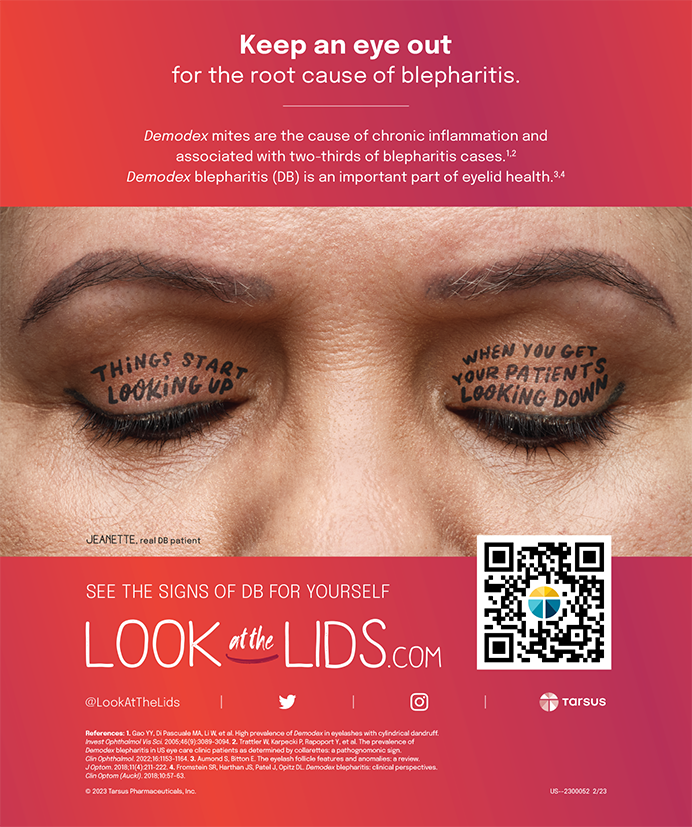
Over the past several decades, we have developed clever and effective surgical remedies for many of the ills that befall the eye. The art of removing the cataractous lens and replacing it with an artificial one could arguably be the most successful procedure in all of medicine. Impressive strides in surgical treatment of the various pressure-related optic neuropathies we call glaucoma have revolutionized our management of this disease. Also, our retina colleagues continue to find new ways to slow the progression of diabetic microvascular disease and age-related macular degeneration. In short, ophthalmologists have become quite adept at fixing the eye when it is broken. But how much of our collective effort has been directed toward preventing these problems from developing in the first place?
Many eye care physicians dismiss the notion of prevention of ocular pathology as an exercise in futility. Cataracts appear in our systemically sickest patients but also in our most healthy yogis, joggers, and vegans. Indeed, some degree of cataract formation seems to inexorably accompany aging. Most forms of glaucoma also seem to be elusive targets for prevention. Although some studies suggest that physical activity may decrease the risk of glaucoma,1-3 other studies are inconclusive or even suggest that static, dynamic, or aerobic exercise might exacerbate glaucoma.4-6
The incidence of myopia is increasing at an alarming rate, and the trend seems linked to increasing performance of near work and lack of outdoor play in children.7,8 It is estimated that, by 2050, more than half of the world’s population will be myopic, and 10% will be highly myopic.9 When we see most humans beginning to exhibit a myopic phenotype that would essentially have been a death sentence a few thousand years ago, we can surmise that there is something very powerful at work. That something is a biological adaptation of axial length and keratometry to allow prolonged viewing of a smartphone at a working distance of 5 inches.
Many risk factors for common ocular pathologies are difficult or impossible to mitigate, but some targets for preventive efforts stand out. As of 2017, approximately 100 million Americans were diabetic or prediabetic.10 The looming societal costs of diabetes are staggering to contemplate. Retinal vascular disease and cataract are the most obvious diabetes-associated ocular pathologies, but glaucoma is probably indirectly linked as well through the associated conditions of obesity and sleep apnea.11,12
A trip to any big-box retailer reveals stacks and stacks of over-the-counter nasal steroid sprays for the treatment of allergic rhinitis. In 2018, more than $700 million worth of over-the-counter nasal steroid sprays were sold in the United States.13 Prescription steroids add to this astonishing total. Intranasal and inhaled corticosteroids are well-known causes of cataract and glaucoma, and, although newer steroid preparations are touted as being safer in this regard, every experienced cataract surgeon has seen patients with very early-onset cataracts whose sole risk factor was use of a so-called safe steroid. Similarly, reversible elevations in IOP have been reported with the use of these drugs, despite studies claiming that this does not occur.14
The looming myopia epidemic may represent the toughest challenge of all for eye care physicians. The dramatic shift toward the use of handheld devices has spurred the development of better near vision solutions in our cataract and refractive surgery patients, but this same phenomenon is creating more myopia in our children. Getting these children to put down their screens and go outside and play may make eradicating diabetes and allergic rhinitis look easy. Although our tendency as surgeons is to imagine new ways to correct these varied problems, some of our attention should be directed toward preventing them in the first place.
Steven J. Dell, MD | Chief Medical Editor
1. Yip JL, Broadway DC, Luben R, et al. Physical activity and ocular perfusion pressure: the EPIC-Norfolk eye study. Invest Ophthalmol Vis Sci. 2011;52(11):8186-8192.
2. Tseng V, Yu F, Coleman AL. Exercise intensity and risk of glaucoma in the national health and nutrition examination survey. Paper presented at: The American Academy of Ophthalmology Annual Meeting; November 11-14, 2017; New Orleans, LA.
3. Chromiak JA, Abadie BR, Braswell RA, et al. Resistance training exercises acutely reduce intraocular pressure in physically active men and women. J Strength Cond Res. 2003;17(4):715-720.
4. McMonnies CW. Intraocular pressure and glaucoma: Is physical exercise beneficial or a risk? J Optom. 2016;9(3):139-147.
5. Dickerman RD, Smith GH, Langham-Roof L, et al. Intra-ocular pressure changes during maximal isometric contraction: Does this reflect intra-cranial pressure or retinal venous pressure? Neurol Res. 1999;21(3):243-246.
6. Kiss B, Dallinger S, Polak K, et al. Ocular hemodynamics during isometric exercise. Microvasc Res. 2001;61(1):1-7.
7. Sherwin JC, Reacher MH, Keogh RH, et al. The association between time spent outdoors and myopia in children and adolescents. Paper presented at: The American Academy of Ophthalmology Annual Meeting; October 22-25, 2011; Orlando, FL.
8. He M, Xiang F, Zeng Y, et al. Effect of time spent outdoors at school on the development of myopia among children in China: a randomized clinical trial. JAMA. 2015;314(11):1142-1148.
9. Holden BA, Fricke TR, Wilson DA, et al. Global prevalence of myopia and high myopia and temporal trends from 2000 through 2050. Ophthalmology. 2016;123(5):1036-1042.
10. New CDC report: More than 100 million Americans have diabetes or prediabetes [press release]. Centers for Disease Control and Prevention. July 18, 2017. https://www.cdc.gov/media/releases/2017/p0718-diabetes-report.html. Accessed December 10, 2018.
11. Lin CC, Hu CC, Ho JD, et al. Obstructive sleep apnea and increased risk of glaucoma: a population-based matched-cohort study. Ophthalmology. 2013;120(8):1559-1564.
12. Sergi M, Salemo DE, Rizzi M, et al. Prevalence of normal tension glaucoma in obstructive sleep apnea syndrome patients. J Glaucoma. 2007;16(1):42-46.
13. Salazar D. Numbers game. Drug Store News. August 25, 2018:32.
14. S,ims,ek A, Bayraktar C, Doguan S, et al. The effect of long-term use of intranasal steroids on intraocular pressure. Clin Ophthalmol. 2016;10:1079-1082.




